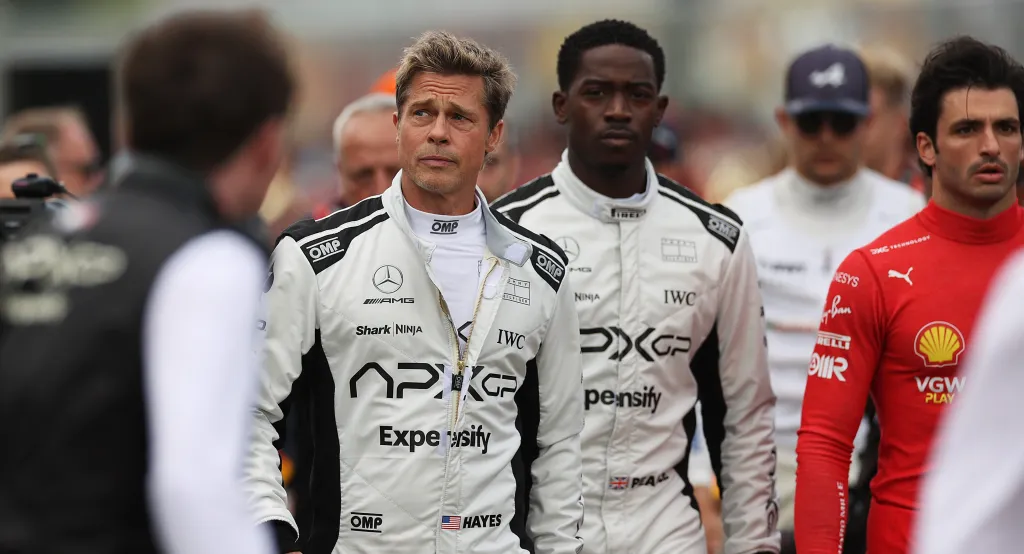
Apple’s Formula 1 racing drama isn’t done chasing lap records. “F1 The Movie” will return to IMAX theaters on Friday, August 8, with a wider expansion on August 15. Tickets are already on sale, giving fans one more chance to feel the rumble before summer winds down.
The move isn’t just about bragging rights, it’s about smart timing, distribution economics, and getting the most out of one of the most expensive original films ever made.
Why Bring It Back?
“F1” has been a monster hit, crossing $555 million globally to become the highest-grossing original feature of the year and Apple’s biggest film ever, overtaking Brad Pitt’s own “World War Z” ($540 million, unadjusted for inflation). IMAX alone accounts for $85 million, the highest of any movie this year, with 23% of its North American opening and 19% of its global debut coming from the format.
For Warner Bros., Apple, and IMAX, those premium-format numbers are reason enough to give the movie another lap, but the cost of making it makes the re-release even more logical.
An Expensive Production
Bringing “F1 The Movie” to life required a near two-year filming schedule (2023–2024), complicated by the SAG-AFTRA strike. The shoot involved real Formula 2 cars, filming on actual Formula 1 tracks, and moving crews to multiple international locations, all of which pushed the estimated production budget close to $300 million.
However, extensive brand sponsorships helped offset costs, potentially bringing the net production budget down to around $250 million. On top of that, Warner Bros. and Apple reportedly spent $100–125 million on marketing, putting the total investment somewhere between $350–375 million before a single ticket was sold.
How the Money Flows
In the U.S., the revenue split between studios and theaters is front-loaded:
- Week 1: Studios can take 60–65% of ticket sales for tentpole releases.
- Each following week: The studio’s cut drops, while the theater’s share increases.
- On average: Across a full run, the split is about 50–55% domestic, ~40% for most overseas markets, and only ~25% from China.
Based on reported grosses, $175.29M domestic, $379.71M international (including $9M from China) — the studio’s total take so far is roughly:
- Domestic: $92.03M
- International ex-China: $148.28M
- China: $2.25M
That’s about $242.56M in studio revenue to date.
The Break-Even Gap
With an estimated total cost of $350M, the film is still around $107.44M short of breaking even from its theatrical run. That figure is based on studio share, not total box office gross, meaning the re-release will need to generate significantly more than $107M in ticket sales to close that gap, depending on the domestic/international mix.
Why This Timing Works
By re-releasing “F1 The Movie” in IMAX after its main theatrical cycle, Warner Bros. and Apple essentially get another “opening week” on premium-priced screens, resetting their percentage take for those showings. Theaters get a proven crowd-puller in a quieter release window, boosting both ticket and concession sales without the marketing risk of an untested title.
The Studio’s Perspective
Warner Bros. Pictures Global Distribution President Jeff Goldstein explained:
“Audiences around the world headed to theaters in droves to witness Formula 1 racing like never before… We jumped at the opportunity to give fans another go-round, or to experience it for the first time, via IMAX’s premiere screens and sound, before summer is over.”
IMAX CEO Rich Gelfond called it their highest-grossing Hollywood film of the year, adding:
“We know ‘F1 The Movie’ still has plenty of gas in the tank and audiences will come back again to experience it as intended in IMAX.”
Bottom Line
This isn’t just a fan treat, it’s a calculated move to close the revenue gap on one of the priciest original productions in years. For audiences, it’s one last chance to see Brad Pitt and those track-level camera rigs in their full glory. For studios, it’s a high-margin encore lap. For theaters, it’s a late-summer boost. And for IMAX, it’s proof the big-screen spectacle still moves the needle.
